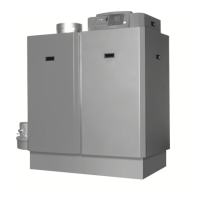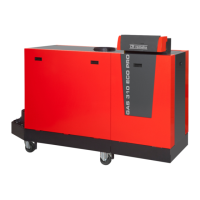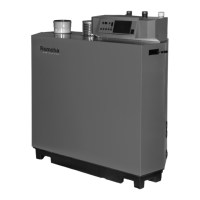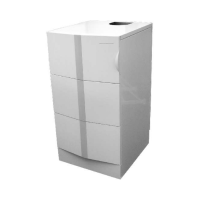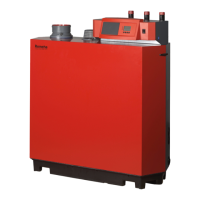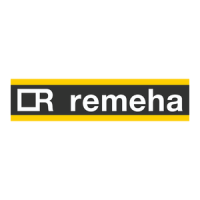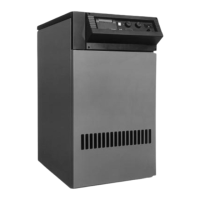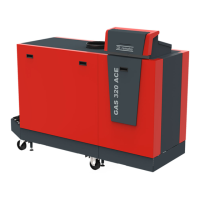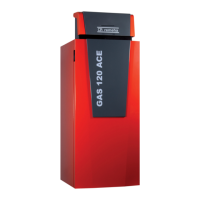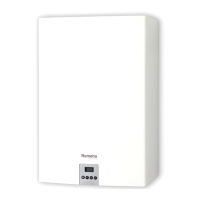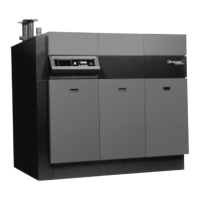
Do you have a question about the REMEHA GAS 3002 ECO and is the answer not in the manual?
| Boiler type | Condensing |
|---|---|
| Fuel type | Natural Gas |
| Water pressure | 1-3 bar |
| Max working pressure | 3 bar |
| Flue diameter | 80/125 mm |
Boiler construction details, heat exchangers, fan, controls, wiring, and casing.
Premix burners with metal fibre cover, ensuring low noise and low NOx emission.
Up to 98.5% at Hi (88.7% at Hs) at 80/60°C.
Up to 98% at Hi (88.3% at Hs) at 80/60°C and up to 108.1% at Hi (97.4% at Hs) at 40/30°C.
Average 0.38% at Hi (0.34% at Hs) at an average boiler water temperature of 45°C.
Average 108% at Hi (97.2% at Hs) at an average boiler water temperature of 35°C.
Parts transport, casing mounting, and general installation preparation.
Shows installation arrangements, required space, and connection options.
Shows support surface of the boiler with connections to the left; can be mirrored for right connections.
Max water temp 110°C (sealed), 95°C operating; min return 20°C.
Boiler section tested at 12 bar; operates at 0.8 to 6 bar.
Flow limited by differential temp; auto-restart if flow sufficient; min/max flow formulas.
Fill with mains cold water; system flush, limited make-up water, hardness limits; advice on chemicals.
Noise level approx. 60 dBA at 1 meter, usually no sound absorbent material needed.
Boiler and circuits weather compensated, separate pumps for each circuit.
Setup for multiple boilers, including water-side shutdown.
Boiler types (ventilated/sealed) and requirements for room sealed operation.
Material, construction, and sloping of flue gas components.
Details flue construction and maximum lengths for ventilated operation.
Describes room sealed operation, tables for max lengths of flue gas discharge/air supply piping.
Electronic controls, safety features, and operational modes (high/low, modulating).
Overview of the control panel, its components, and display.
Lists components like main switch, display, and buttons.
Advanced microprocessor control with menu-driven operation and diagnostics.
Access to basic operating information and settings via menus.
Access via security code 0012; options for service settings, test, history data, factory level.
Flowchart illustrating the boiler control menu structure and options.
Diagrams illustrating the gas train's design for different boiler sizes.
Details the components of the gas/air ratio control system.
Overview of monitored functions and failure protection mechanisms.
Protection against flame loss using ionization probes.
Safety feature using temperature sensors to prevent operation without sufficient water.
Safety feature preventing overheating via temperature sensors.
Protection against improper flue gas movement via pressure sensor.
Boiler delivery state and transport considerations.
Details connection types, locations, and safety valve fitting.
Test and operating pressure specifications.
Requirements for safety valve size and location.
Procedures for filling, refilling, and venting the heating system.
Instructions for draining the boiler and installation.
Consult local gas authority for adequate pressure/supply; conform to safety regulations.
Procedure for testing the gas installation for leaks.
Specifies required gas supply and inlet pressures.
Conformance to electrical regulations and local requirements.
Boiler prewiring and contractor's responsibilities for power supply.
Power supply details and input power by section size.
Overview of boiler control modes: modulating and high/low.
Options for controlling modulation internally or externally.
Boiler can be controlled high/low using volt free contacts or RS 232.
General information on 24V DC inputs and potential-free contacts.
Description of inputs for switching off the boiler.
Description of input to lock the boiler operation.
Connection for a gas leak detection device.
Potential-free contact for alarm or ready status signals.
Contacts for low and high operating message signals.
Connection point for an external gas valve.
Terminal for external 230V power supply, not switched.
Key technical specifications for the control box and boiler.
Step-by-step procedure for initial boiler start-up and checks.
Safe procedures for turning off the boiler.
Guidance on using diagnostic tools and understanding failure messages.
Description of how faults are indicated and managed by the control unit.
Importance of cleaning for optimal performance and preventing soot.
Detailed steps for boiler maintenance and component cleaning.
